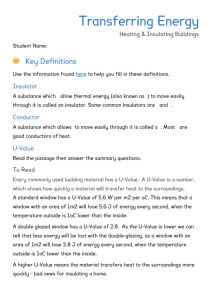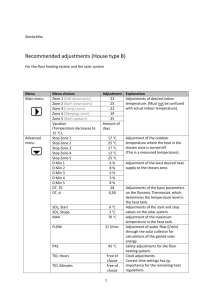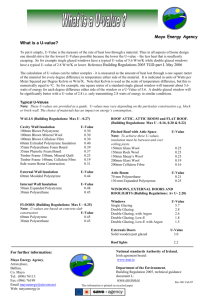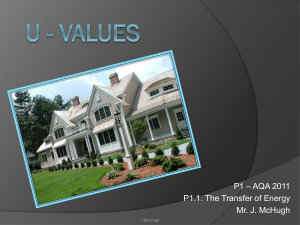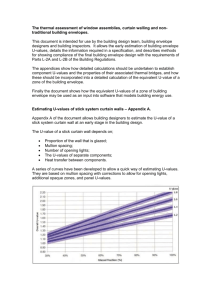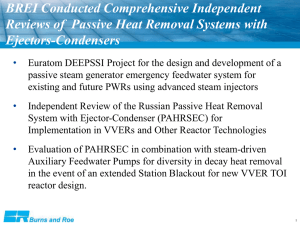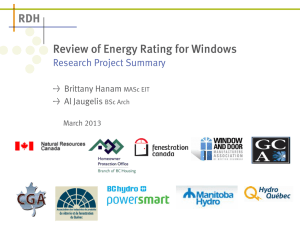BSF Passive Schools
advertisement
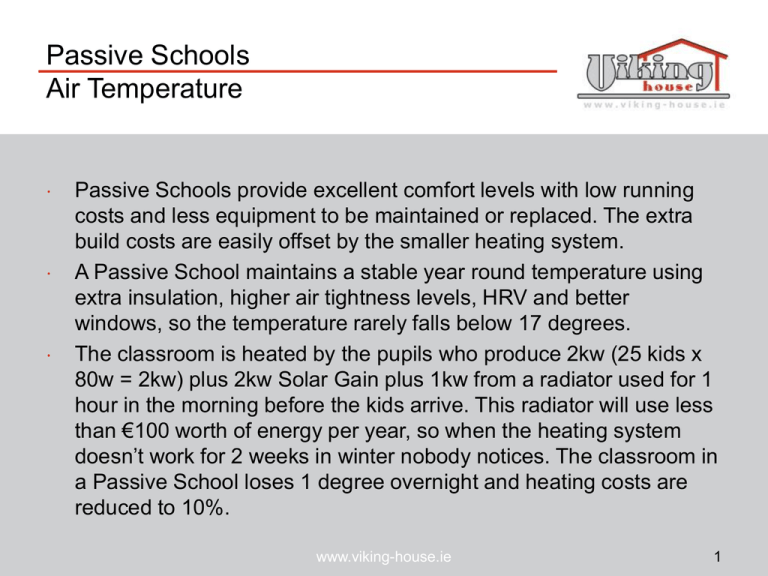
Passive Schools Air Temperature Passive Schools provide excellent comfort levels with low running costs and less equipment to be maintained or replaced. The extra build costs are easily offset by the smaller heating system. A Passive School maintains a stable year round temperature using extra insulation, higher air tightness levels, HRV and better windows, so the temperature rarely falls below 17 degrees. The classroom is heated by the pupils who produce 2kw (25 kids x 80w = 2kw) plus 2kw Solar Gain plus 1kw from a radiator used for 1 hour in the morning before the kids arrive. This radiator will use less than €100 worth of energy per year, so when the heating system doesn’t work for 2 weeks in winter nobody notices. The classroom in a Passive School loses 1 degree overnight and heating costs are reduced to 10%. www.viking-house.ie 1 Riedberg school, Frankfurt basic facts Opened in Area Occupants Construction type Ventilation Heating Air tightness Extras 2004 8,000 m² (6,300 m² + gym) 650 – 675 Concrete externally insulated HRV Wood pellet boiler n50=0.46/h 30 kW photovoltaics www.viking-house.ie 2 Riedberg school, Frankfurt energetic performance Calculated heat demand U-value walls U-value window frames U-value glazing U-value roof U-value ground slab Temperatures during the winter between 19.5 and 20.6 °C Almost no overheating during the summer Average in 2006 (warm summer) was 22.9 °C CO2 concentration is constantly below the recommended threshold of 1,500 ppm Heat consumption during the winter of 2005/2006 was 90 % below German standard 15 kWh/(m²a) 0,17 W/(m²K) 0,8 W/(m²K) 0,6 W/(m²K) 0,11 W/(m²K) 0,21 W/(m²K) www.viking-house.ie 3 Overheating Control Draught free building Summer overheating is easily controlled by cooling the Thermal Mass using automatic actuator controlled vents at night and closing blinds within the windows by day. If the classroom gets too hot, just open a window~even in winter! The heat generating kitchen is kept to the North side of the building. Earth heat exchangers deliver 15-16 degree air when its 25 degrees outside and 7 degree air when its minus 10 degrees outside. This simple technology cuts the size of your heating or cooling system in half. Cold surfaces and leaky buildings cause draughts. The 17 degree surface temperature of Passive School windows stops convection and the high level of air tightness ensures the building is draught free, so the child near the windows isn’t cold. www.viking-house.ie 4 Riedberg school, Frankfurt costs Total Additional costs Construction costs Est. payback period in 2003 Est. payback period in 2005 With oil prices hitting 130 $ / barrel payback period is even shorter today After payback period energy savings of several thousand euros per year 16.7 mio € ~3% 1,110 €/m² 30 years 12 years www.viking-house.ie 5 Cold Bridge free Construction Warmer Walls Cold Bridging is eliminated at design and construction stages, delivering walls without cold spots. With a 15 degree wall, the thermostat is set to 25 degrees for comfort, with a 19 degree wall, the stat is lowered to 20 degrees. Warmer surfaces reduce condensation eliminating fungus/mould growth. www.viking-house.ie 6 Heinrich v. Kleist school, Frankfurt basic facts Opened in Area Construction type Ventilation Heating Air tightness Extras 2007 1,338 m² extension, concrete Wolf KG 160 Gigant shares heating with existing building n50=0.24/h green roof insulation is CFC-free www.viking-house.ie 7 Lighting Biomass-PV Lighting is the single biggest energy guzzler in British Schools and its excessive use can be easily reduced by adopting Passive School principles. Lights in UK schools often default to on because the controls are too complicated. Passive Schools usually have 3-3.5m high ceilings and windows are high in the walls to deliver natural light across the whole classroom. Up lighters that light the ceiling are a no-no, all lights should automatically switch off at break time and be manually switched back on. Night time security lights are operated by motion sensors that only work after dark. Biomass boilers can be a maintenance nightmare if you pick the wrong model and PV often doesn’t do what it says on the tin, but they both need replacing every 15 years. If the only difference between a Code 4 and a Code 6 school is the size of the PV array? then It makes more economical sense to build a PassiveCode 4 school and buy in Green Zero Carbon electricity. www.viking-house.ie 8 Heinrich v. Kleist school, Frankfurt energetic performance / costs Calculated heat demand 14 kWh/(m²a) = 1.4 liters of oil per square meter per year U-value walls U-value window frames U-value glazing U-value roof U-value ground slab Total costs: Construction costs: 0.126 W/(m²K), Rockwool 0.81 W/(m²K) 0.6 W/(m²K) 0.095 W/(m²K) EPS insulation 0.144 W/(m²K) EPS and foam glass 2,692 €/m² 2,053 €/m² www.viking-house.ie 9 Humidity Air Quality Humidity is controlled using HRV during the heating season and natural ventilation for the rest of the year. The ventilation rate for a Passive School is based on the occupancy levels, not on the volume of the building as per the UK building regs. The Passive Schools with the lowest Co2 levels use HRV, and the performance of the pupils is 20% above average, so they can spend 2-3 years less in school (joke). Without HRV the ventilated energy losses are massive and air quality is low, 500 pupils require 20m3/hr = 10,000m3/hr + 10% ~ 11,000m3/hr regardless of how voluminous the building is. HRV for a 300 pupil school costs €150,000 which is cheap when you consider the benefits achieved from higher air quality and energy efficiency. Children need more air than adults and are more sensitive to low air quality. The Co2 level was below 1000ppm for 99.9% of the time in the 1st Belgian Passive School. Low air resistance ductwork is beneficial to avoid draughts. www.viking-house.ie 10 Preungesheim primary school, Frankfurt energy performance Calculated heat demand U-value walls U-value window frames U-value glazing U-value roof U-values floor/ground slab 15 kWh/(m²a) = 1.5 liters of oil per square meter per year 0.13 W/(m²K) 0.8 W/(m²K) 0.6 W/(m²K) 0.092 W/(m²K), 0.133 – 0.164 W/(m²K) Total costs Construction costs Calc. payback period (2008) 21,85 mio € 1.41 mio € / 1,538 €/m² 9.3 years Construction time Area Occupants 05/2006 – 08/2007 5,152 m² 530 www.viking-house.ie 11 Consultancy Quality Control We can guide clients through the Passive Schools labyrinth by offering the following services: Get involved in your project at the design stage to optimise building orientation and shape to reduce its energy demand Cost benefit analysis calculating the payback period for any extra costs incurred building your Passive School (PHPP) Passive House Planning Package calculations Cold Bridge (CB) calculation and elimination using Therm Condensation risk analysis and drying ability of your wall build up using WUFI Supply and fit of our CB free PassivHaus certified foundation system delivering U-values as low as 0.08 Guaranteed Airtightness result of n50=0.60/h from our Airtightness SWAT team Passive House certification on completion www.viking-house.ie 12
